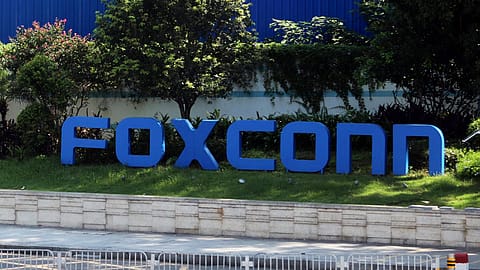Why are the missing Chinese techies from Foxconn’s Chennai facility a symptom of a bigger problem
Beijing’s silent grip: Why China’s hold over India’s tech and trade lifelines is hard to break.

Recently, Foxconn, the world’s largest contract manufacturer of electronic products, withdrew hundreds of Chinese engineers and technicians from its Apple iPhone production units in Chennai and Bengaluru. The exodus of these experts even caused significant operational challenges for Foxconn’s India facilities, as the company was augmenting its production and increasing the export of iPhones made in India to key markets, including the United States, according to reports.
While there was no official explanation for the Taiwanese company’s decision, many believe it was made under pressure from China, as Foxconn’s main manufacturing and component sourcing base for global manufacturing remains in China. Trade experts are linking the timing of the withdrawal of Chinese experts from its India facilities and the imminent interim trade deal that India is expected to announce with the U.S, China’s arch-rival in global trade.
Either China wants to remind India of its dependence on Chinese raw materials, technology, and technical human resources, or it wants to signal to the U.S. that a preferential trade agreement may not be significant if that country cannot bypass China and allow the supply chain to move to India at will, experts say. It could be both as well.
While disruptions in the the global supply chain of key raw materials, such as rare earth minerals, were attributed to the U.S.-China trade war, the renewable energy and electric vehicle industries of every country suffered due to the export restrictions China imposed on these battery minerals, mainly due to its monopoly over these raw and processed materials.
Thus, while Chinese action targeted against the U.S could have an indirect impact on other trade partners like India, the threat of direct dependency on China for key raw materials and components—from pharmaceutical ingredients to battery minerals to iPhone components—is not small.
The Indian government has been acknowledging this threat for some time now, but dependency continues. "India’s trade deficit with China hit $100 billion as India’s imports from China surged in FY2025, while exports declined sharply. Chinese firms now supply over 80% of India’s needs in laptops, solar panels, antibiotics, viscose yarn, and lithium-ion batteries — deepening strategic vulnerabilities," notes a recent analysis done by New Delhi-based trade think tank Global Trade Research Initiative (GTRI).
Since mid-2023, China has imposed curbs on exports of critical minerals such as gallium and germanium, essential for India’s electronics, EV, and defence industries. In late 2024, the restrictions were extended to graphite, dealing a direct blow to India’s clean energy and battery manufacturing sectors.
Citing “national security” reasons, Beijing has cloaked these actions in strategic ambiguity, while tightening its grip on supply chains that India is still dependent on. The pressure mounted further in June 2025, when Chinese battery giant CATL reportedly directed Foxconn to withdraw all Chinese engineers from its manufacturing unit near Chennai.
The move disrupted timelines and coordination at a crucial time for India’s electronics and EV supply chain build-out, the GTRI analysis notes. "China’s actions may be signally to avoid any conditions in the FTA that discourage the use of Chinese-origin components in exports to the US. China’s message is blunt: India’s industrial growth remains dangerously exposed to Chinese inputs, and any attempt to “de-risk” supply chains will carry short-term pain," says Ajay Srivastava, founder, GTRI.
The India-China bilateral trade numbers are self-evident of India’s growing economic reliance on China. While Indian imports from China continue to surge, Indian exports have steadily declined, reducing India’s share in bilateral trade to a mere 11.2%, compared to 42.3% two decades ago.
For instance, in the pharmaceutical sector, India imported $166.3 million worth of erythromycin from China, accounting for 97.7% of its global imports of that antibiotic. China supplied 88.1% of India’s total antibiotic imports, forming the backbone of India’s pharmaceutical ingredient supply.
(INR CR)
In electronics and semiconductors, India imported $151.6 million worth of silicon wafers from China (96.8% share), and $1.06 billion in flat panel display modules (86%). Computer monitors ($376.5 million) also saw a 66.8% share from China. Imports of printed circuit boards ($612.2 million), memory chips ($1.75 billion), and microprocessors ($1.65 billion) were also heavily reliant on China, with shares ranging between 37% and 40.5%.
In consumer electronics, laptops and tablets topped the list with $4.45 billion in imports, 80.5% of which came from China. Smartphones accounted for $259.7 million (58.8%), while smartphone components and parts accounted for $763.8 million (55.4%) and $7.15 billion (51.7%), respectively.
In the renewable energy sector, India imported $1.36 billion worth of solar cells and $1.7 billion of solar panels, with Chinese imports making up 82.7% and 78.9% of those, respectively. For lithium-ion batteries — vital for EVs and energy storage — India imported $2.26 billion, of which 75.2% came from China.
According to GTRI study, the machinery and industrial goods category also shows equally deep exposure as embroidery machinery imports were worth $351.7 million, with 91.4% sourced from China, aluminium foil rolled ($261.2 million – 82.8%), aluminium plates ($265.4 million – 91.6%), and safety glass ($547.1 million – 84.8%) were dominated by Chinese supply. In power equipment and components, battery charger imports accounted for $117.3 million (68.2%), electric inverters for $200.5 million (72.3%), and UPS/inverter systems for $641.7 million (49.9%).
There is a saving grace, though.
According to Srivastava, nearly 90% of India’s imports from China fall within the low- to medium-technology range, including products such as textiles, agricultural machinery, taps, valves, pumps, compressors, building hardware, moulds, bearings, motors, nuts and bolts, and even stationery. These are not beyond India’s technological reach. A strategic and phased approach can significantly reduce this dependence, he hopes.